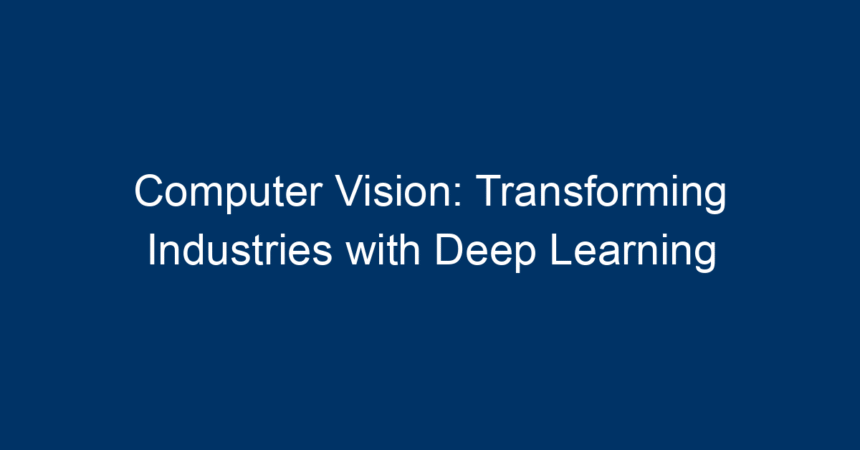In today’s digital landscape, the intersection of artificial intelligence (AI) and machine learning is revolutionizing the way we interact with technology. At the forefront of this transformation is computer vision, a field that enables machines to interpret and make decisions based on visual data. With advancements in deep learning, industries ranging from healthcare to transportation are experiencing significant shifts in efficiency and innovation. This article explores how computer vision is reshaping these sectors and provides insights into its future implications.
What is Computer Vision?
Computer vision is a subfield of artificial intelligence that focuses on enabling machines to understand and interpret visual information from the world. By utilizing deep learning techniques—such as convolutional neural networks (CNNs)—computer vision systems can analyze images and videos to recognize patterns, detect objects, and facilitate decision-making processes.
The Role of Deep Learning in Computer Vision
Deep learning is a type of machine learning that uses neural networks with multiple layers to process data. In computer vision, deep learning algorithms have drastically improved the accuracy and efficiency of image and video analysis. By training on vast datasets, these models learn to extract features from visual inputs, achieving results that often surpass human abilities.
Applications of Computer Vision Across Industries
1. Healthcare: Enhancing Diagnostic Accuracy
In the healthcare sector, computer vision plays a pivotal role in diagnostics. From analyzing medical imaging data, such as X-rays and MRIs, to monitoring patient health through wearable devices, computer vision algorithms can detect anomalies that may go unnoticed by human eyes.
Radiology
Recent advancements have equipped radiologists with tools that use computer vision to identify tumors and other medical conditions with unparalleled accuracy. For instance, studies indicate that deep learning algorithms can diagnose breast cancer in mammograms as effectively as expert radiologists, significantly reducing the time taken for evaluations.
2. Automotive: Pioneering Autonomous Driving
The automotive industry is undergoing a massive shift toward automation, largely fueled by computer vision. Autonomous vehicles rely on cameras and sensors to gather real-time data about their surroundings, making split-second decisions to navigate safely.
Object Recognition and Safety
Computer vision systems are essential for identifying pedestrians, road signs, and obstacles. This technology enhances safety features like automatic braking and lane-keeping assistance, greatly reducing accident rates and improving overall driver safety.
3. Retail: Revamping the Shopping Experience
In retail, computer vision is transforming the shopping experience through various applications, enhancing customer engagement and operational efficiency.
Smart Checkout Systems
Retailers are increasingly adopting systems that utilize computer vision for smart checkouts, allowing customers to bypass traditional checkout lines. By recognizing items in a shopping cart and automatically processing transactions, these systems save time and reduce labor costs.
4. Agriculture: Boosting Crop Yields
Agriculture is another sector benefiting profoundly from computer vision. Farmers are employing visual data analysis to maximize crop yields and optimize resource consumption.
Precision Farming
By using drones equipped with cameras, farmers can monitor crop health in real-time. Computer vision algorithms analyze aerial imagery to detect pests, nutrient deficiencies, and other issues, enabling timely interventions that enhance agricultural productivity.
The Future of Computer Vision
Emerging Trends
As technology continues to evolve, so too will the capabilities of computer vision. Several trends are shaping the future of this industry:
-
3D Vision: The integration of 3D imaging technologies will enable machines to understand spatial relationships better, enhancing applications in robotics and virtual reality.
-
Edge Computing: Processing visual data on the device itself rather than relying on cloud computing will reduce latency, making real-time applications more feasible, especially in sectors like automotive and healthcare.
- Augmented Reality (AR): AR technologies will leverage computer vision to create immersive experiences, merging the digital and physical worlds seamlessly.
Challenges and Ethical Considerations
Despite its potential, computer vision faces challenges, particularly concerning data privacy and algorithmic bias. Ensuring that computer vision systems are transparent and equitable is crucial as they become more embedded in everyday life.
Actionable Insights for Businesses
-
Invest in Training: To harness the full potential of computer vision, organizations should invest in training their workforce to understand and implement these technologies effectively.
-
Explore Partnerships: Collaborating with technology providers can ease the integration of computer vision solutions, allowing businesses to innovate without starting from scratch.
-
Stay Informed: Keeping abreast of the latest developments in computer vision and deep learning will ensure that businesses remain competitive in an evolving landscape.
- Prioritize Ethics: Establishing ethical guidelines for the use of computer vision technology can build trust among customers and stakeholders, fostering a positive reputation.
Conclusion
The impact of computer vision driven by deep learning is profound and far-reaching across multiple industries. As technology advances, its applications will continue to expand, creating opportunities for enhanced efficiency, safety, and innovation. By understanding the developments in computer vision and adapting to its challenges, businesses can position themselves at the forefront of this technological revolution. Embracing computer vision is no longer an option but a necessity for those looking to thrive in an increasingly automated world.




